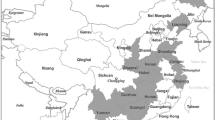Abstract
Concern about ensuring old-age support in 4-2-1 families—consisting of four older people (paternal and maternal grandparents), two parents, and only one child—has risen with the increase in the number of families with only one child. In this article, using life table data and probability theory, we examine survival probabilities and coexistence durations for China’s 4-2-1 family structure, as well as urban and rural differences and conduct a sensitivity analysis. We find that once the grandparents have all entered the “old-age” phase (over 60 years old), the probability that all four will survive is only 0.61. The four grandparents are likely to coexist for 16 years after the birth of their grandchild, then one will die and the remaining three will probably spend another 8 years together; finally, after another dies, the surviving two will coexist for another 5 years. There is no significant difference between urban and rural families in terms of the duration of their coexistence. As the ages at which the parents had their child rise, the durations become shorter. The pressure of old-age support in such families is not as severe as expected.


Similar content being viewed by others
References
Burgess R (2002) Modernization and son preference in the People’s Republic of China. ADB, Manila
Chen CX (2000) Economic independence is the pre-condition to a happy life for the rural elderly—an analysis on ways of supporting the rural elderly based on Homans’ exchange theory. Popul Res 24(2):53–58
Chu JH (2001) Study on financial dependence and activities of daily living of the oldest population segment among the Chinese elderly. Chin J Popul Sci 15(s):66–70
Du P, Wu C (2006) The self-reliance of the Chinese elderly: status and change. Popul Res 30(1):50–56
Guo ZG (2004) A further study on low fertility in China in the 1990s. Chin J Popul Sci 18(4):16–24
Guo ZG, Liu JT, Song J (2002) The present population policy and the future of family structure. Chin J Popul Sci 16(1):1–11
Hong YY, Liu WT (2000) The social and psychological perspective on elderly care. In: Liu WT, Kending H (eds) Who should care for the elderly? An east-west value divide. Singapore University Press, Singapore
Ikels C (1997) Long-term care and the disabled elderly in urban China. In: Sokolovsky J (ed) The cultural context of aging: worldwide perspectives. Bergin & Garvey, Westport
Lavely W (2001) First impressions from the 2000 Chinese census. Popul Dev Rev 27(4):755–769
Li S, Sun F (2003) A mortality analysis of China’s 2000 population census data: a preliminary examination. China Rev 3(2):31–48
Li SZ, Sun FB, Jiang QB (2005) Death reports from the fifth population census in 2000 in China. In: Population Census Office of the State Council and National Bureau of Statistics (eds) Population in a transformational period: National key project of population census in 2000. China Statistics Press, Beijing
Liang QS (2004) Four-two-one structure: a special mixture of society, family and the relationship between generations. Popul J 26(2):61–65
Liu HY, Liu YZ (1996) Only children and their future marriage structure. Chin J Popul Sci 10(3):33–37
Pan GY (2003) Collection of data of 2001 national family planning and reproductive health survey data collection. China Population Press, Beijing
Population Census Office of the State Council (2002) China population census data in 2000. China Statistics Press, Beijing
Qi XF, Guo ZW (2007) Micro simulation models for “4-2-1” families and their applications. Popul Res 31(3):32–40
Randel J, German T, Ewing D (1999) The ageing and development report: poverty, independence and the world’s older people. Earthscan Publications Ltd., London
Silverstein M, Cong Z, Li SZ (2007) Grandparents who care for their grandchildren in rural China: benefactors and beneficiaries. In: Cook IG, Powell JL (eds) New perspectives on China and aging. Nova Science Publishers Inc, New York, pp 49–71
Song J (2000) The four-two-one structure: its formation and development. Chin J Popul Sci 14(3):41–45
Tu P (1995) China’s population aging and population control. Chin Soc Sci 6:61–70
Walfish D (2001) China’s census: national count reveals major societal changes. Science 292(5523):1823
Wang XY (2003) A study on old age support in China. M.A. Thesis, Northeast Normal University
Xie BG (2000) The essence of Chinese filial piety. Shanghai Academy Social Science Press, Shanghai
Xu Q, Yuan Y (1997) The role of family support in old-age security in China. In: China Population Association (eds) 23rd IUSSP General Population Conference: a symposium on the demography of China. Beijing. Xin Hua Press, Beijing, pp 265–273
Yang SZ, Wang GZ (2007) An indirect estimation method for the quantity of only children. Chin J Popul Sci 21(4):58–63
Acknowledgments
This work is jointly supported by the Program for Chang Jiang Scholars and Innovative Research Team in University of the Chinese Ministry of Education (Project No. IRT0855) and the National Social Science Foundation of China (Project Nos. 09XSH005, 08BRK004). We would like to thank to the Editor and two anonymous reviewers for their valuable comments.
Author information
Authors and Affiliations
Corresponding author
Additional information
Responsible editor: D. J. H. Deeg.
Rights and permissions
About this article
Cite this article
Jiang, Q., Sánchez-Barricarte, J.J. The 4-2-1 family structure in China: a survival analysis based on life tables. Eur J Ageing 8, 119–127 (2011). https://doi.org/10.1007/s10433-011-0189-1
Published:
Issue Date:
DOI: https://doi.org/10.1007/s10433-011-0189-1




